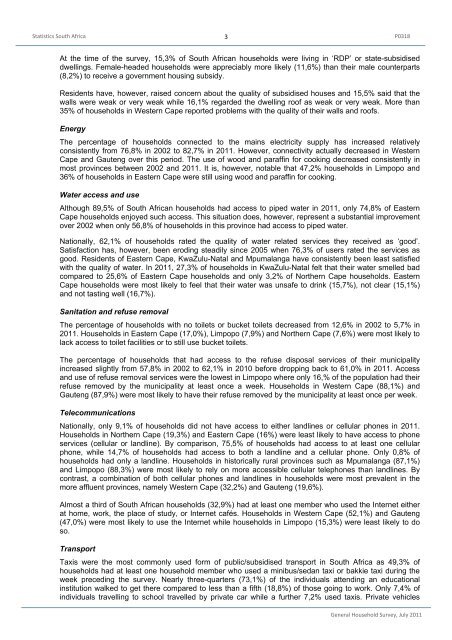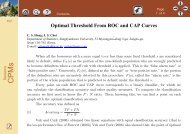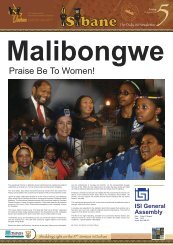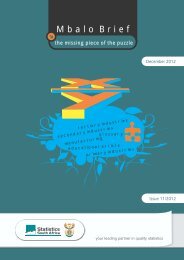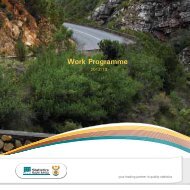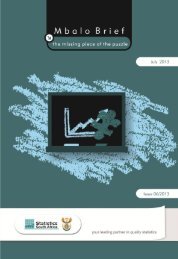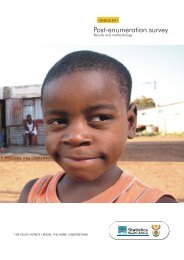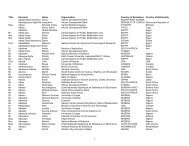General household survey - Statistics South Africa
General household survey - Statistics South Africa
General household survey - Statistics South Africa
Create successful ePaper yourself
Turn your PDF publications into a flip-book with our unique Google optimized e-Paper software.
<strong>Statistics</strong> <strong>South</strong> <strong>Africa</strong> 3<br />
P0318<br />
At the time of the <strong>survey</strong>, 15,3% of <strong>South</strong> <strong>Africa</strong>n <strong>household</strong>s were living in ‘RDP’ or state-subsidised<br />
dwellings. Female-headed <strong>household</strong>s were appreciably more likely (11,6%) than their male counterparts<br />
(8,2%) to receive a government housing subsidy.<br />
Residents have, however, raised concern about the quality of subsidised houses and 15,5% said that the<br />
walls were weak or very weak while 16,1% regarded the dwelling roof as weak or very weak. More than<br />
35% of <strong>household</strong>s in Western Cape reported problems with the quality of their walls and roofs.<br />
Energy<br />
The percentage of <strong>household</strong>s connected to the mains electricity supply has increased relatively<br />
consistently from 76,8% in 2002 to 82,7% in 2011. However, connectivity actually decreased in Western<br />
Cape and Gauteng over this period. The use of wood and paraffin for cooking decreased consistently in<br />
most provinces between 2002 and 2011. It is, however, notable that 47,2% <strong>household</strong>s in Limpopo and<br />
36% of <strong>household</strong>s in Eastern Cape were still using wood and paraffin for cooking.<br />
Water access and use<br />
Although 89,5% of <strong>South</strong> <strong>Africa</strong>n <strong>household</strong>s had access to piped water in 2011, only 74,8% of Eastern<br />
Cape <strong>household</strong>s enjoyed such access. This situation does, however, represent a substantial improvement<br />
over 2002 when only 56,8% of <strong>household</strong>s in this province had access to piped water.<br />
Nationally, 62,1% of <strong>household</strong>s rated the quality of water related services they received as ‘good’.<br />
Satisfaction has, however, been eroding steadily since 2005 when 76,3% of users rated the services as<br />
good. Residents of Eastern Cape, KwaZulu-Natal and Mpumalanga have consistently been least satisfied<br />
with the quality of water. In 2011, 27,3% of <strong>household</strong>s in KwaZulu-Natal felt that their water smelled bad<br />
compared to 25,6% of Eastern Cape <strong>household</strong>s and only 3,2% of Northern Cape <strong>household</strong>s. Eastern<br />
Cape <strong>household</strong>s were most likely to feel that their water was unsafe to drink (15,7%), not clear (15,1%)<br />
and not tasting well (16,7%).<br />
Sanitation and refuse removal<br />
The percentage of <strong>household</strong>s with no toilets or bucket toilets decreased from 12,6% in 2002 to 5,7% in<br />
2011. Households in Eastern Cape (17,0%), Limpopo (7,9%) and Northern Cape (7,6%) were most likely to<br />
lack access to toilet facilities or to still use bucket toilets.<br />
The percentage of <strong>household</strong>s that had access to the refuse disposal services of their municipality<br />
increased slightly from 57,8% in 2002 to 62,1% in 2010 before dropping back to 61,0% in 2011. Access<br />
and use of refuse removal services were the lowest in Limpopo where only 16,% of the population had their<br />
refuse removed by the municipality at least once a week. Households in Western Cape (88,1%) and<br />
Gauteng (87,9%) were most likely to have their refuse removed by the municipality at least once per week.<br />
Telecommunications<br />
Nationally, only 9,1% of <strong>household</strong>s did not have access to either landlines or cellular phones in 2011.<br />
Households in Northern Cape (19,3%) and Eastern Cape (16%) were least likely to have access to phone<br />
services (cellular or landline). By comparison, 75,5% of <strong>household</strong>s had access to at least one cellular<br />
phone, while 14,7% of <strong>household</strong>s had access to both a landline and a cellular phone. Only 0,8% of<br />
<strong>household</strong>s had only a landline. Households in historically rural provinces such as Mpumalanga (87,1%)<br />
and Limpopo (88,3%) were most likely to rely on more accessible cellular telephones than landlines. By<br />
contrast, a combination of both cellular phones and landlines in <strong>household</strong>s were most prevalent in the<br />
more affluent provinces, namely Western Cape (32,2%) and Gauteng (19,6%).<br />
Almost a third of <strong>South</strong> <strong>Africa</strong>n <strong>household</strong>s (32,9%) had at least one member who used the Internet either<br />
at home, work, the place of study, or Internet cafés. Households in Western Cape (52,1%) and Gauteng<br />
(47,0%) were most likely to use the Internet while <strong>household</strong>s in Limpopo (15,3%) were least likely to do<br />
so.<br />
Transport<br />
Taxis were the most commonly used form of public/subsidised transport in <strong>South</strong> <strong>Africa</strong> as 49,3% of<br />
<strong>household</strong>s had at least one <strong>household</strong> member who used a minibus/sedan taxi or bakkie taxi during the<br />
week preceding the <strong>survey</strong>. Nearly three-quarters (73,1%) of the individuals attending an educational<br />
institution walked to get there compared to less than a fifth (18,8%) of those going to work. Only 7,4% of<br />
individuals travelling to school travelled by private car while a further 7,2% used taxis. Private vehicles<br />
<strong>General</strong> Household Survey, July 2011


